ebook
Some trace the concept of an e-reader, a device that would enable the user to view books on a screen, to a 1930 manifesto by Bob Brown, written after watching his first "talkie" (movie with sound).In an article, Jennifer Schuessler writes: "The machine, Brown argued, would allow readers to adjust the type size, avoid paper cuts and save trees, all while hastening the day when words could be 'recorded directly on the palpitating ether.The final device was planned to include audio recordings, a magnifying glass, a calculator, and an electric light for night reading.Seeking a worthy use of this resource, he created his first electronic document by typing the United States Declaration of Independence into a computer in plain text.[28] Hart planned to create documents using plain text to make them as easy as possible to download and view on devices.[28] Dedicated hardware devices for ebook reading began to appear in the 70s and 80s, in addition to the main frame and laptop solutions, and collections of data per se.The final summary report was produced in 1989 by the U.S. Army Research Institute for the Behavioral and Social Sciences, authored by Robert Wisher and J. Peter Kincaid.[30] A patent application for the PEAM device,[31] titled "Apparatus for delivering procedural type instructions", was submitted by Texas Instruments on December 4, 1985, listing John K. Harkins and Stephen H. Morriss as inventors.[32] Early e-books were generally written for specialty areas and a limited audience, meant to be read only by small and devoted interest groups.[citation needed] In 1993, Paul Baim released a freeware HyperCard stack, called EBook, that allowed easy import of any text file to create a pageable version similar to an electronic paperback book.[34] Unlike most other formats, PDF documents are generally tied to a particular dimension and layout, rather than adjusting dynamically to the current page, window, or another size.In the late 1990s, a consortium formed to develop the Open eBook format as a way for authors and publishers to provide a single source-document which many book-reading software and hardware platforms could handle.Several scholars from the TEI were closely involved in the early development of Open eBook, including Allen Renear, Elli Mylonas, and Steven DeRose, all from Brown.In early 2000, NLM set up the PubMed Central repository, which stores full-text e-book versions of many medical journal articles and books, through co-operation with scholars and publishers in the field.[57] In 2014, The New York Times predicted that by 2018 e-books will make up over 50% of total consumer publishing revenue in the United States and Great Britain.[58] Some of the major book retailers and multiple third-party developers offer free (and in some third-party cases, premium paid) e-reader software applications (apps) for the Mac and PC computers as well as for Android, Blackberry, iPad, iPhone, Windows Phone and Palm OS devices to allow the reading of e-books and other documents independently of dedicated e-book devices.Examples are apps for the Amazon Kindle,[59] Barnes & Noble Nook, iBooks, Kobo eReader and Sony Reader.The most popular e-readers[151] and their natively supported formats are shown below: Most e-book publishers do not warn their customers about the possible implications of the digital rights management tied to their products.Scanning a book produces a set of image files, which may additionally be converted into text format by an OCR program.[example needed] This is useful in fields such as information technology where topics can change quickly in the months that it takes to write a typical book.[165] In the space that a comparably sized physical book takes up, an e-reader can contain thousands of e-books, limited only by its memory capacity.Many e-readers have a built-in light source, can enlarge or change fonts, use text-to-speech software to read the text aloud for visually impaired, elderly or dyslexic people or just for convenience.[174] For example, all books printed before 1928 are in the public domain in the United States, which enables websites to host ebook versions of such titles for free.[175] Depending on possible digital rights management, e-books (unlike physical books) can be backed up and recovered in the case of loss or damage to the device on which they are stored, a new copy can be downloaded without incurring an additional cost from the distributor.[177] One obstacle to wide adoption of the e-book is that a large portion of people value the printed book as an object itself, including aspects such as the texture, smell, weight and appearance on the shelf.[182] While a paper book is vulnerable to various threats, including water damage, mold and theft, e-books files may be corrupted, deleted or otherwise lost as well as pirated.Where the ownership of a paper book is fairly straightforward (albeit subject to restrictions on renting or copying pages, depending on the book), the purchaser of an e-book's digital file has conditional access with the possible loss of access to the e-book due to digital rights management provisions, copyright issues, the provider's business failing or possibly if the user's credit card expired.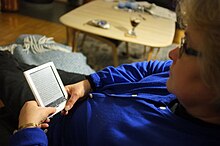
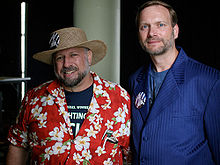
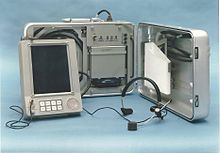
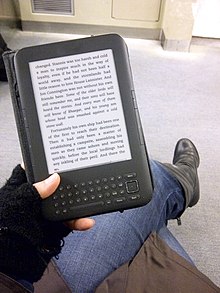





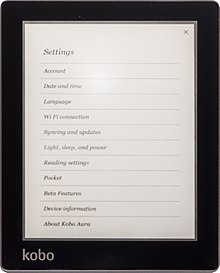
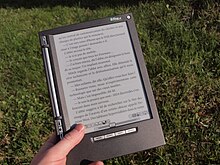

e-readerE-commerceSoftwareStreaming mediaAdvertisingAuctionsBankingDVD-by-mailDistributionFood orderingGroceryMarketplacePharmacyRide-hailingTravelOnline shoppingComparison shoppingSocial commerceTrading communitiesWalletMobile commercePaymentTicketingCustomer serviceCall centreHelp deskLive support softwareE-procurementPurchase-to-paySuper-appsflat-panel displaydesktop computerslaptopstabletssmartphonesInternetwebsitesimageshardcoverbookmarkstabletdigital textbooksBob BrowntalkieorthographyportmanteauIndex ThomisticusThomas AquinasRoberto BusaÁngela Ruiz RoblesFerrol, SpainNational Museum of Science and TechnologyA CoruñaDouglas EngelbartStanford Research InstituteHypertext Editing SystemAndries van DamBrown UniversityhyperlinkingRoderick ChisholmUS NavyDynaTextOpen eBookMichael S. HartGregory NewbyProject GutenbergHackers on Planet EarthUniversity of IllinoisUnited States Declaration of IndependenceDynabookU.S. Department of DefenseTexas InstrumentsJ. Peter KincaidData DiscmanLibrary of the FutureHyperCardComparison of e-book formatsText Encoding InitiativeSteven DeRoseGoogle Bookspublic domainHachetteHarperCollinsMacmillanPenguin Random HouseSimon & Schustere-book lendingAmerican Library Associationapplication softwareOverdriveHooplaU.S. National Library of MedicinePubMedPubMed CentralJournal Article Tag Suiteelectronic publishingcopyright infringementinterlibrary loanPatron-driven acquisitionAssociation of American University PressesAndrew W. Mellon FoundationInternet ArchiveOpen LibraryComparison of e-readersComparison of e-book softwaremobile electronic devicee-booksAmazon.comKindlehardcover booksquarterdigital editionsoftware applicationsAndroidBlackberryiPhoneWindows PhonePalm OSAmazon KindleBarnes & Noble NookiBooksKobo eReaderSony ReaderGalicia, SpainAugmentTed Nelson